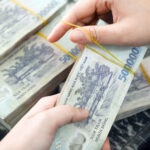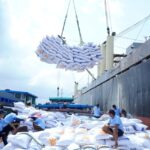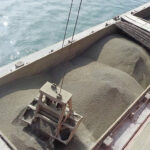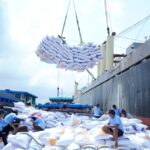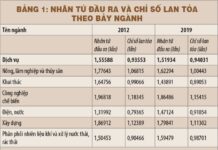Bac Lieu: The Emerging Shrimp Industry Hub of Vietnam
Bac Lieu: Forging Ahead as Vietnam’s Shrimp Industry Epicenter
Vietnam is one of the top three shrimp-producing countries globally, and Bac Lieu Province has consistently ranked among the top provinces in the country for freshwater shrimp farming. With a strategic location in the Mekong Delta region of southwestern Vietnam, Bac Lieu boasts a flat terrain devoid of hills or mountains, thus avoiding significant seismic activity. Its vast paddy fields, intricate network of rivers and canals, and favorable climate provide the ideal conditions for the province to excel in aquaculture, particularly shrimp farming.
Bac Lieu’s economy relies primarily on three key export products: shrimp, rice, and salt. Shrimp takes the lion’s share, contributing over 95% of the province’s export turnover. Home to 48 seafood processing factories equipped with modern technology, Bac Lieu has an impressive annual processing capacity of 294,000 tons. The province’s shrimp products are exported to major markets worldwide, including the US, Japan, the EU, China, South Korea, and many other countries.
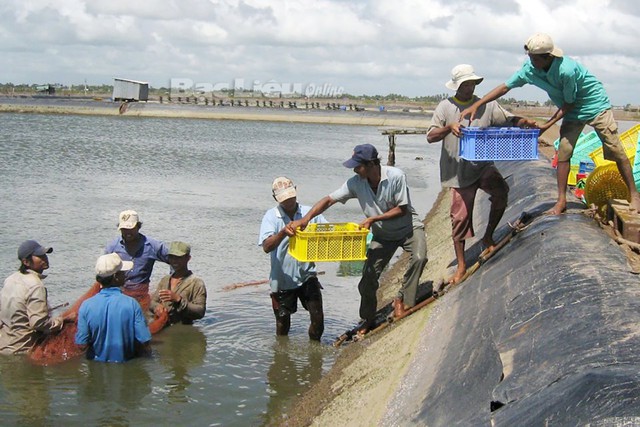
Farmers harvesting shrimp from super-intensive farming. Photo: Bac Lieu Newspaper.
Recently, the provincial government conducted a conference to evaluate the three-year implementation of the project “Building Bac Lieu into the Center of the National Shrimp Industry.” The conference revealed significant achievements in the province’s shrimp industry, with balanced development in three critical areas: seed production, commercial shrimp farming, and processing.
In terms of shrimp seed production, Bac Lieu leads the Mekong Delta region in producing high-quality shrimp seeds, accounting for over 50% of the region’s output and more than 22% nationwide. The province is home to 360 shrimp seed production and breeding facilities, with an annual capacity of 40 billion post larvae.
In the processing and export sector, Bac Lieu’s shrimp export volume reached 96,980 tons in 2023, a substantial increase of 29.5% compared to 2020. Export turnover also witnessed a notable rise, reaching 1.03 billion USD, a 27.37% increase compared to 2020.
Bac Lieu is currently home to 48 seafood processing factories, with a designed capacity of 294,000 tons per year. These factories cater to various markets, including Europe, the US, Japan, South Korea, and China. Most of the factories are equipped with modern production lines and technology, ensuring that their products meet quality and food safety standards for both domestic consumption and export.

Bac Lieu farmers harvesting green-legged shrimp. Photo: Can Tho Newspaper.
Bac Lieu has set ambitious targets for the “Building Bac Lieu into the Center of the National Shrimp Industry” project by 2025. These include producing 40-45 billion shrimp seeds, cultivating shrimp in 147,900 hectares of ponds, and achieving a processed shrimp export volume of 120,000 tons. The province aims to export 90,000 tons of shrimp in 2025, accounting for over 90% of its total seafood export volume.
For the 2026–2030 period, the province targets an export turnover of 1.5 billion USD for aquatic products, with a shrimp production volume of 341,000 tons. A key focus is on establishing production chains that integrate processing, consumption, and stable output for over 40% of aquaculture products, with 70% of these products having traceable origins.
Lu Van Hung, Secretary of the Provincial Party Committee, affirmed that to achieve the goal of becoming the country’s shrimp industry center and the leading shrimp producer in Vietnam, Bac Lieu needs to continue investing in and promoting the efficiency of super-intensive shrimp farming models that apply advanced technology. This should go hand in hand with environmental protection, climate change adaptation, and the development of integrated farming models such as shrimp-rice and shrimp-forest in the province.
Where Does Vietnamese Shrimp Go?
According to the Global Aquaculture Alliance, global shrimp production is estimated at 5.6 million tons in 2023 and is projected to reach 5.88 million tons in 2024. Vietnam, along with Ecuador, China, India, and Indonesia, accounts for approximately 74% of global shrimp production.
Data from the Ministry of Agriculture and Rural Development shows that in the first seven months of the year, Vietnam’s seafood export turnover reached an estimated 5.29 billion USD, a 7.3% increase that places it second in export turnover in the agricultural sector. Shrimp exports alone brought in 2 billion USD, a 7.5% increase compared to the same period last year, retaining its top position in the seafood industry.
Ranking among the top three shrimp exporters worldwide, Vietnam accounts for 13-14% of global shrimp export value. Vietnamese shrimp is exported to approximately 100 countries and territories, with China, the US, Japan, and the EU being the biggest importers.

Workers processing shrimp in a factory.
China is the largest market for Vietnamese lobster. Exports to China and Hong Kong in the first seven months of the year reached 399 million USD, an 18% increase compared to the same period last year. The US market followed closely with an export turnover of 303 million USD, a slight increase of 1%, while exports to Japan and the EU reached 229 million USD and 217 million USD, a decrease of 3% and an increase of 13%, respectively, compared to 2023.
The Vietnam Association of Seafood Exporters and Producers (VASEP) predicts that exports to the US, EU, and other major markets will grow positively in the last months of the year as importers tend to increase their purchases to prepare for the year-end holiday season.
If business activities remain favorable and no negative changes occur, the shrimp industry’s export target of 4 billion USD for this year is well within reach.
The Best Just Got Better: Vietnam’s Rice Triumphs Again
Indonesia, the second-largest importer of Vietnamese rice, has just announced a tender for almost half a million tons of rice, with delivery requested in October and November.

